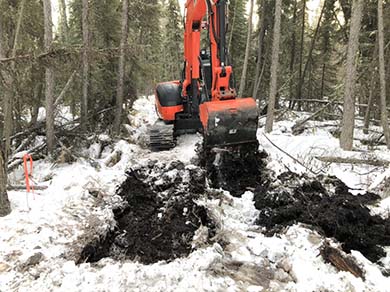
Preparing the foundation
The tree planting process begins well before trees are planted in the ground. A vital step in the process is preparing the sites where trees will be planted. Between 6 to 12 months before planting a tree, it is essential to prepare the planting site to create optimal conditions for trees to survive and thrive.
Site preparation begins with assessing the factors that limit or prevent plant growth at the planting site. These factors can include:
- compacted soils
- competition from other vegetation
- availability of soil nutrients
- soil moisture levels
- temperature
- wildlife browsing
Limitations can be addressed using a variety of site preparation methods and techniques to improve the growing conditions of the site.

Text version
A chart comparing 5 different limiting factors and site preparation techniques that can address them.
The first limiting factor describes issues relating to soil moisture.
In a wet site, the preferred site preparation technique is mounding, while in a dry site the preferred technique is scalping, scarification or disc trenching.
The second limiting factor describes competition.
In a wet site, the preferred site preparation technique is mounding and plowingFootnote *. In a dry site, the preferred technique is scalping, scarification, mixingFootnote * and disc trenchingFootnote *.
The third limiting factor is compacted soils.
In a wet site the preferred site preparation technique is mounding and plowing. In a dry site, the preferred technique is mixing, winged subsoiler, and straight ripper.
The fourth limiting factor is nutrient poor soils.
In a wet site, the preferred site preparation technique is mounding. In a dry site, the preferred technique is mixing and disc trenching.
The fifth limiting factor is having cold soils.
In a wet site, the preferred site preparation technique is mounding and plowing. In a dry site, the preferred technique is scalping, scarification, mixing, and disc trenching.

Text version
A chart depicting a timeline for completing critical tasks for successful planting. The chart has an x-axis with months out of the year. It starts with April and goes until November the following year.
There are nine total tasks listed:
- Site assessments should be done between April to November of year 1.
- Site preparation should be done between July year 1 to April year 2. Soil salvaging and stockpiling during disturbance applies to site preparation.Footnote *
- Seed collection should occur from April to November of year 1.
- Plant ordering should be done July to October of year 1.
- Growing plants in greenhouses should be done November of year 1 to June of year 2.
- The first seeding should occur July to November of year 1.
- The second seeding should occur April to July of year 2.
- Planting should occur from May to September of year 2.
- Monitoring should occur from May to November of year 2.
Benefits of fast-growing species
In afforestation sites, particularly contaminated sites, decommissioned mines and gravel pits, landfills, and sewage treatment facilities, fast-growing species—such as willow and poplar—can play a pivotal role as a pioneer species in forest landscape rehabilitation, site restoration and phytoremediation. For example, willow can be an effective choice in places where other tree species will have difficulty establishing and growing without intensive site inputs.
Fast-growing tree species can offer multiple environmental, social and economic benefits including:
- Storing higher rates of carbon (17.8 to 24.3 tonnes per hectare per year versus 6 tonnes per hectare per year for mature forests)
- Improving soil in sites degraded by industrial activity
- Treating sewage wastewater, landfill leachate and municipal and industrial organic biosolids at a lower cost than other methods
- Reducing the risk of groundwater contamination, and wind and soil erosion
- Providing forested areas and food sources for wildlife
- Increasing some forms of biodiversity (e.g., butterflies, beetles and ground vegetation), landscape heterogeneity, and connectivity between wildlife habitats and forested recreational areas
Sharing knowledge to support the 2 Billion Trees program
The 2 Billion Trees (2BT) program is committed to providing recipients with the knowledge they need to succeed. Below is a list of research projects, knowledge exchange products, tools and activities that have been developed or are in the process of being developed to support tree planting under the program and enhance the survival and productivity of planted trees.
Research projects:
- Linking site conditions to black ash wood growth and quality
- The application of wood ash and effects on tree growth rate
- High resolution productivity mapping to support 2BT using remote sensing
Knowledge exchange products, tools and activities:
- Grow a green future: A guide for successful tree planting
- Methodology for the reclamation of phosphogypsum stacks in Canada using afforestation
Research results and other knowledge will become available on an ongoing basis and will be added to the 2BT knowledge inventory.
Stay connected
If you have questions or want to join the distribution list for program updates, email the 2BT Program.
- 2BT knowledge inventory (Canadian Forest Service publications)
- Series of technical notes published by the Northern Alberta Institute of Technology’s (NAIT) Applied Research Centres